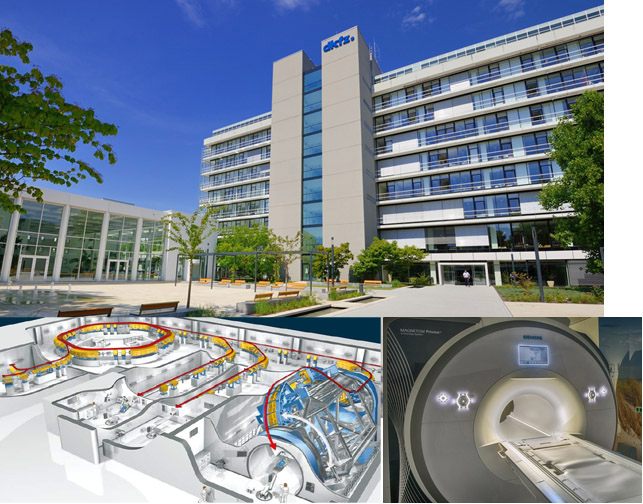Seminar: Methods of Physics in Biology and Medicine
Sommersemester 2025
Tuesday, 18:00 (c.t.) – 19:45 h
(Starting time moved to c.t., i.e. 18:15 h)
(This seminar is offered every summer and winter semester. )
This seminar will be offered in hybrid mode (presentations are to be given at DKFZ).
You can participate either in person in INF 223, Room number F.01.088 or online via Zoom. The seminar will be transmitted via a room video conferencing system. See plan for location of the seminar room below.
Zoom access:
https://dkfz-de.zoom-x.de/j/88052936406
Meeting-ID: 880 5293 6406
Registration: Closed
Schedule
| Date | Name | Topic |
|---|---|---|
| 22.04.2025 | Aishwarya Kannan | Single photon emission computed tomography (SPECT) |
| Anusha Antony Antony | Radiobiology (effects of ionizing radiation on biological systems / cells) | |
| 29.04.2025 | Lilly Metten | Radiotherapy with heavy ions |
| Rakshitha Murali | Magnetoencephalography (MEG) | |
| 06.05.2025 | Luca Kempny | NMR imaging of tissue water protons (MRI) |
| Jessica Sielaff | Interaction of ionizing radiation with matter | |
| 13.05.2025 | Tabita Bomhard | Planning of radiotherapeutic treatments: 2D and 3D planning techniques, excluding IMRT |
| David Sabasch | PET hybrid devices (PET/CT, MR/PET) | |
| 20.05.2025 | Daniel Di Marco | Positron emission tomography (PET) |
| David Palatz | X–nuclei imaging (17O, 23Na, 39K, 3He...) | |
| 27.05.2025 | Michael Gotzmann | Intensity modulated radiotherapy (IMRT) |
| Mirija Claß | Perfusion imaging: MRI contrast agents, arterial spin labeling (ASL) | |
| 03.06.2025 | Alexander Wiegand | Radiography with ions |
| Hannes Trescher | Monitoring energy metabolism in vivo with 31P NMR | |
| 10.06.2025 | Yuan Lai | Functional MRI (fMRI) for measuring brain activation |
| Marike Schneider | Physics of radiotherapy with protons, in particular eye treatments | |
| 17.06.2025 | Konstantinos Koritsidis | FLASH radiotherapy |
| Tariq Hammoudeh | Radionuclide therapy | |
| 24.06.2025 | Yeqingqing Huang | Brachytherapy |
| 01.07.2025 | Evans Siaw | Ultrasound imaging (US) |
| Shahithya Vel Ilango | Photoacoustic imaging | |
| 08.07.2025 | Julius Laub | Laser ion / proton acceleration |
| Julian Wendel | Fluorescence imaging and immunofluorescence | |
| 15.07.2025 | Bhuvaneshwari Muniappan | Bioluminescence imaging |
| Moritz Thierfeld | Diffusion-Weighted MRI and Diffusion Tensor Imaging (DTI) (lesion detection, brain connectivity mapping) | |
| 22.07.2025 | Xinlu Wu | Radiation chemistry and radiation bio–chemistry |
| Juan Alvarez | MR–guided radiotherapy (MR–Linac / MR–cobalt therapy) |
To receive 6 credit points: talk, written report and regular attendance are required.
- duration of talk: 40 min + 5 min questions (in case there is only one talk on the specific date, talks are allowed to be longer, if desired.)
- Talks will be given on-site at DKFZ and in parallel be transmitted via Zoom.
- written report: overview of the presented
topic, maximum 10 pages, to be handed in until
01. October 2025
(Please submit
your report and the slides of your talk via email
using the following filename
convention: <last name>, <first
name>_<matriculation number>_<abbreviated
title>_[report/slides].)
PD Dr. Tristan A. Kuder (t.kuder@dkfz.de), Prof. Joao Seco (j.seco@dkfz.de), Prof. Dr. Leif Schröder (leif.schroeder@dkfz.de)
Access to the seminar room: Due to a construction site, access to the main entrance is not obvious: Please refer to the following map: https://www.google.com/maps/d/edit?mid=16mEtQXetbcNAr7GM5Sxl5P1QreuCdRk&usp=sharing
Coming from the west (point A), walk along the northern side of the building in east direction to the construction site (blue line on the map), go up the stairs to the main entrance. In the main entrance hall, go the white staircase up to the first floor. You will be directly in front of the seminar room (see red markers on the map).

